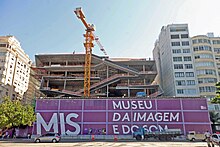Carmen Miranda Museum

Facade of the new museum in June 2014.
|
|
| Established | August 5, 1976 |
|---|---|
| Location |
Rio de Janeiro |
| Visitors | 10,000 /year |
| Director | César Soares Balbi |
| Website | Carmen Miranda Museum |
Carmen Miranda Museum, located in the Parque Brigadeiro Eduardo Gomes (Flamengo Park), is a museum established in homage to singer and actress Carmen Miranda and open to the public since 1976. The museum has been officially opened on the 21st anniversary of her death.
The museum exhibits iconographic costumes, including her tall fruit hats and platform-heeled shoes, and artifacts belonging to Carmen, as well as many of her records and films. In the second half of 2015, the new headquarters for the Carmen Miranda Museum will be opened at Rio de Janeiro's new Museum of Image and Sound (MIS).
The Carmen Miranda Museum was officially created in 1956, through a decree signed by , Governor of the Federal District. But its inauguration took place twenty years later, on August 5, 1976, by the Governor of Rio de Janeiro . Installed in Flamengo Park, the circular building was designed by architect Affonso Eduardo Reidy, later adapted by architect Ulisses Burlemaqui.
The establishment of the museum was a response to the population and the legion of admirers, especially outsiders from various parts of the world, organized in numerous fan clubs, who wanted a space that could perpetuate the memory of the singer, one of the myths of Brazilian popular music. The museum in Rio de Janeiro, has over 3,500 items which help pay a tribute to the singer and actress Carmen Miranda (Feb.9, 1909-Aug.5, 1955). About 200 items are on display. A great part of the museum collection is available for research upon request.
Roughly 460 of the items in the collection are garments and accessories. You'll see some of the famous platform shoes five-foot tall that Carmen (known as the Pequena Notável, or the "Notable Little One") wore in throughout her career. There are also glam dresses, like the one she wore for her last show, day before she died; and some of her signature turbans, including the one she wore for her wedding. You'll also see plenty of balangandãs - the dangling charms that were part of Carmen's baiana style.
Initially meant as a Flamengo Park leisure center, the construction was adapted for its current use by Ulisses Burlemaqui in 1975.
Currently the museum is closed to the public, while its collection is being prepared to compose the collection of the future of the Museum of Image and Sound (Museu da Imagem e do Som) in Copacabana.
...
Wikipedia
